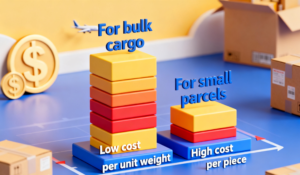Introduction
When it comes to international shipping for small packages, choosing between air freight and express courier services can be quite a question. Most people are aware that choices significantly impact cost, efficiency, and customer satisfaction, but they struggle to understand the differences.
In this article, we will help you understand the fundamental differences between them and show you the steps to make the right decision for your business.
What is Air Freight and How Does it Work?
Air freight involves transporting goods via commercial airlines or dedicated cargo carriers. Traditional air freight typically follows an airport-to-airport model, where shipments are consolidated and transported between airports. Today, door-to-door air freight services are also widely available.
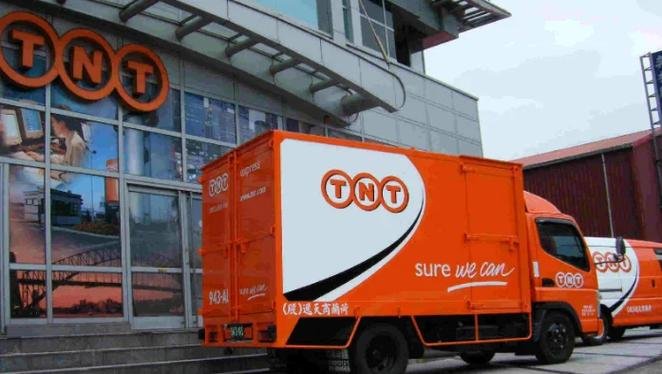
The air freight process typically involves multiple touchpoints:
- Collection from the shipper
- Consolidation at origin
- Airport handling and flight transportation
- Destination processing and customs clearance
- Final delivery arrangements
This multi-step process is designed to handle larger volumes efficiently and is typically organized by a freight forwarder.
What is Express Courier Service?
Express courier service is an integrated, door-to-door service for documents and packages. Global giants like DHL, FedEx, UPS, and TNT control the entire shipping process by operating their own networks of aircraft, vehicles, and facilities.
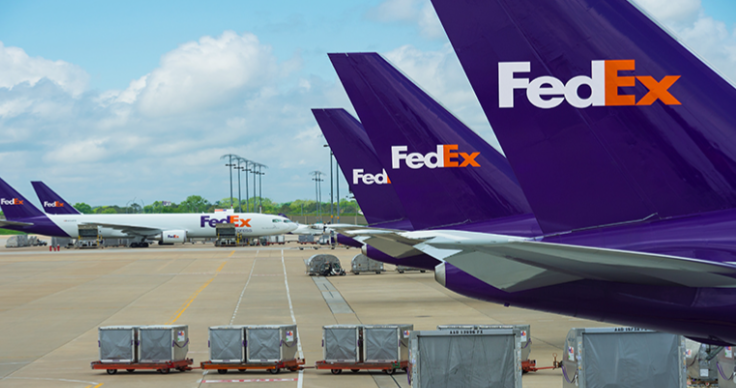
The express courier services focus on speed, convenience, and reliability, and the key features include:
- Pickup, transportation, customs clearance, and final delivery
- Delivery within 3–5 business days for standard services, or 1–3 days for expedited options
- Real-time tracking, insurance, and customer support
The Main Differences Between Air Freight and Express Courier Services
As we know, air freight services and express courier services share many advantages; however, they also differ in several aspects, such as delivery time (speed), cost structure, shipment size/weight limits, and tracking visibility etc. In this article, we will make some comparisons between them.
Delivery Time (Speed)
Regardless of whether it is air freight services or express courier services, potential customers must be more time-sensitive; otherwise, they would choose sea freight services. While even for air freight and express courier services, the delivery time is different.
- Express Courier: 3–7 days (standard), 1–3 days (expedited)
- Air Freight: 8–15 days (standard), 5–7 days (expedited)
- Express couriers also have higher on-time delivery rates (~90%).
Cost Structures
The cost structures of express courier and air freight differ significantly, rooted in their different pricing models: one-stop pricing or itemized pricing.
- Express Courier: All-inclusive pricing (freight, handling, customs, delivery)
- Air Freight: Itemized pricing (breakdown of freight, handling, customs, fees)
- Courier services are cost-effective for small, urgent shipments (≤50 kg); air freight is better for large, non-urgent shipments (≥100 kg).
Service Scope
The cost structures between express courier and air freight are quite different, and the service scopes differ from each other accordingly.
- Express Courier: Door-to-door service with single-point responsibility, automatic tracking, and integrated support.
- Air Freight: Airport-to-airport basis, requiring separate arrangements for ground transport and customs, but offering greater flexibility.
A comparison between the two services
| Factor | Air Freight | Express Courier (e.g., DHL, FedEx, UPS) | Who Cares? |
|---|---|---|---|
| Cost Structure | Cost-effective for volume. Lower cost per kg for heavy shipments (typically 100kg+). Cost is modular (freight + fuel + security + handling + customs brokerage). | Cost-effective for speed & simplicity. Higher cost per kg, but price is often all-inclusive (transport, customs clearance, delivery). | Finance & Procurement: Air Freight optimizes COGS for large orders. Courier simplifies budgeting for smaller, urgent shipments. |
| Speed (Transit Time) | Variable. The flight is fast, but door-to-door time includes consolidation, customs processing, and separate ground transport. Less predictable. | Predictable & Fast. Prioritized, integrated network offers guaranteed, expedited door-to-door timelines (e.g., 2-5 days globally). | Supply Chain Managers: Courier for urgent stock replenishment. Air Freight for planned production runs without immediate deadlines. |
| Service Model | Port-to-Port (Airport-to-Airport) primarily. Door-to-door is possible but requires coordination of multiple parties (freight forwarder, customs broker, trucker). | Door-to-Door. Fully integrated service from pickup to final delivery. Single point of contact and responsibility. | Logistics Coordinators: Courier offers “hands-off” convenience. Air Freight offers control but requires more management. |
| Compliance & Customs | Buyer’s Responsibility (under DAP terms). Requires a separate customs broker (can be arranged by your forwarder). More complex documentation (AWB, invoices, etc.). | Service Provider’s Responsibility. The courier acts as the importer of record and handles all customs clearance seamlessly as part of their service. | Compliance Officers: Courier reduces the administrative burden and risk of customs errors for the shipper/receiver. |
| Tracking & Visibility | Good, but less granular. Tracking provided by your freight forwarder, typically with major milestone updates (e.g., departed, arrived, customs cleared). | Excellent, real-time. Proactive, parcel-level tracking from pickup to delivery with detailed online visibility and notifications. | Customer Service Teams: Courier provides superior tracking data to provide accurate updates to end-customers. |
| Ideal Shipment Profile | High-Volume, Low-Urgency. Palletized goods, large machinery, bulk orders, and shipments where cost is the primary driver. | Low-Volume, High-Urgency. Samples, documents, spare parts, high-value items, and emergency shipments where speed and simplicity are critical. | Sales & Operations: Alignment depends on the nature of the goods and the strategic need for the shipment. |
How to Choose? A Decision-Making Framework For You
Even though they know the main difference between air freight and express courier services now, most people still have no idea how to choose them step by step. In the following article, we will show you a framework for your decision-making.
Step 1. Define Urgency Level
Firstly, confirm the customer’s required delivery date, consider different shipping methods, and potential delays. Especially for time-sensitive and critical goods, the use of expedited services should be considered.
Express couriers like DHL, FedEx, UPS, and SF Express offer various expedited options for urgent parcels and documents. These expedited services can reduce the basic delivery time by 1-4 days, depending on the lane and service level.
The similar expedited air freight service focuses on accelerating the airport-to-airport leg and the necessary ground processes. In this way, it can also reduce the original transit time by 3-7 days or even less.
Step 2. Assess Shipment Characteristics
It’s vital to assess the value and fragility of your packages. High-value items (e.g., electronics, luxury goods) often require enhanced security, insurance coverage, and specialized packaging. Similarly, fragile goods (e.g., glassware, medical equipment) may need cushioning, crating, or even climate-controlled handling to ensure safe transit.
It’s also important to consider any special handling requirements, such as temperature sensitivity (e.g., pharmaceuticals, perishable foods), hazardous materials (e.g., batteries, chemicals), or regulatory compliance (e.g., customs documentation for restricted items).
For regular packages, the delivery cost is determined by ‘volumetric weight’, rather than actual weight, for both air freight and express courier services.
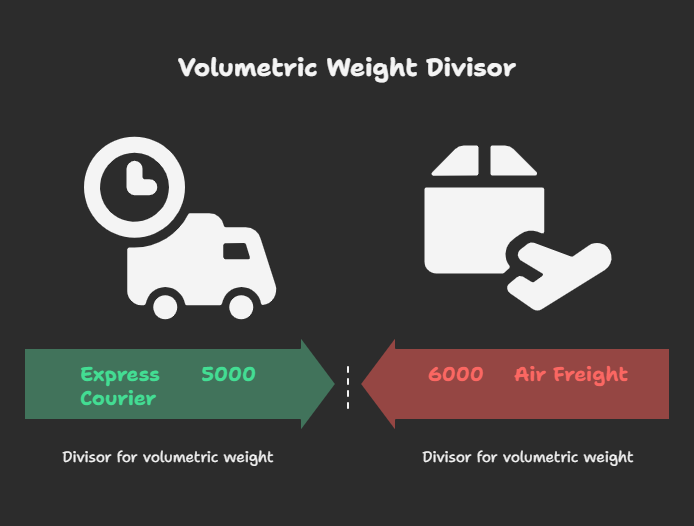
Volumetric Weight = (Length × Width × Height) / Divisor
The key difference is the divisor: Express Courier service (e.g., DHL, FedEx, UPS) uses a divisor of 5000, while Air Freight service uses a divisor of 6000.
The carrier will always charge you based on whichever weight is greater: the actual weight or the volumetric weight.
Let’s see an example below:
Imagine you have a large box of feathers that is 100 cm x 100 cm x 100 cm. Its actual weight is only 50 kg.
Its Volumetric Weight is (100 × 100 × 100) / 5000 = 1,000,000 / 5000 = 200 kg for Express Courier, while (100 × 100 × 100) / 6000 = 1,000,000 / 6000 ≈ 167 kg for Air Freight.
Obviously, the carrier will charge by the volumetric weight because whether 200kg or 167kg is greater than 50kg (its actual weight), and for this large lightweight box, air freight would be cheaper without any other considerations.
Step 3. Evaluate the ‘Total Cost’
The true total cost of ownership (TCO) emerges only when you combine all these visible and hidden factors. And a comprehensive cost evaluation extends far beyond comparing basic freight quotes.
You must compare total shipping costs inclusive of all fees.
- For express couriers, this means clarifying whether rates include fuel surcharges, remote area fees, and customs clearance.
- For air freight, this requires accounting for terminal handling charges, customs brokerage, and final delivery fees—expenses that can easily double a seemingly low “air-only” rate.
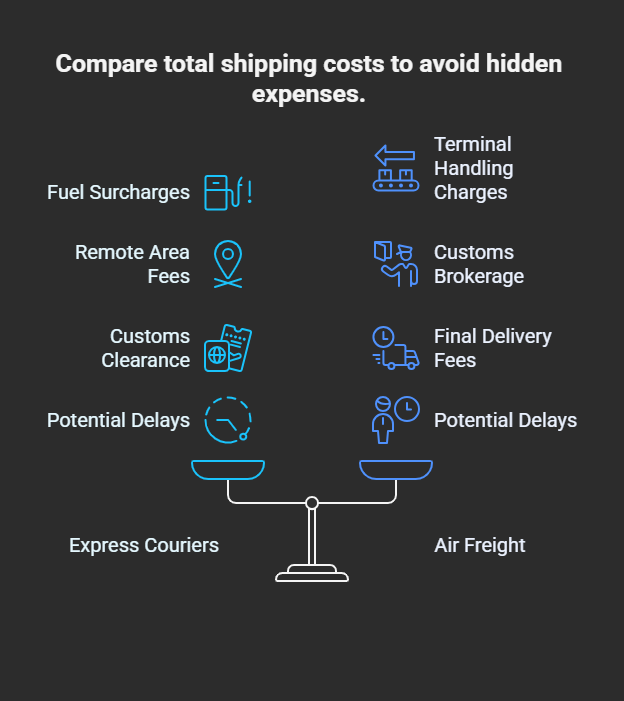
Equally critical is to consider the cost of potential delays (e.g., missed deadlines or production halts).
Step 4: Analyze Destination Factors – Especially for DDP terms
A thorough analysis of destination-specific factors is critical to ensuring seamless delivery, especially under DDP (Delivered Duty Paid) terms.
For instance, remote areas may incur surcharges or lack coverage by standard express carriers, so alternative logistics solutions are necessary. Furthermore, the seller manages all import formalities, including duties, taxes, and documentation under DDP.
Potential Risks:
- Complex customs regulations causing delays
- Stringent inspections leading to hold-ups
- Inefficient port processes resulting in storage fees or penalties
Risk Mitigation Strategies:
- Proactively engage a local customs broker
- Leverage the carrier’s expertise and resources
For DDP shipments, understanding these nuances ensures accurate cost forecasting and prevents operational disruptions, safeguarding both budget and customer satisfaction.
Step 5: Make the Decision
In most cases, you can make your decision after finishing the previous four steps. Let me make it simple: the decision should always be based on your top priorities: cost, speed, or simplicity.
- Choose express couriers for urgent, smaller shipments with full visibility.
- Opt for air freight for larger, less time-sensitive shipments with better cost efficiency.
Remember: a choice will be good when balancing key needs and your budget.
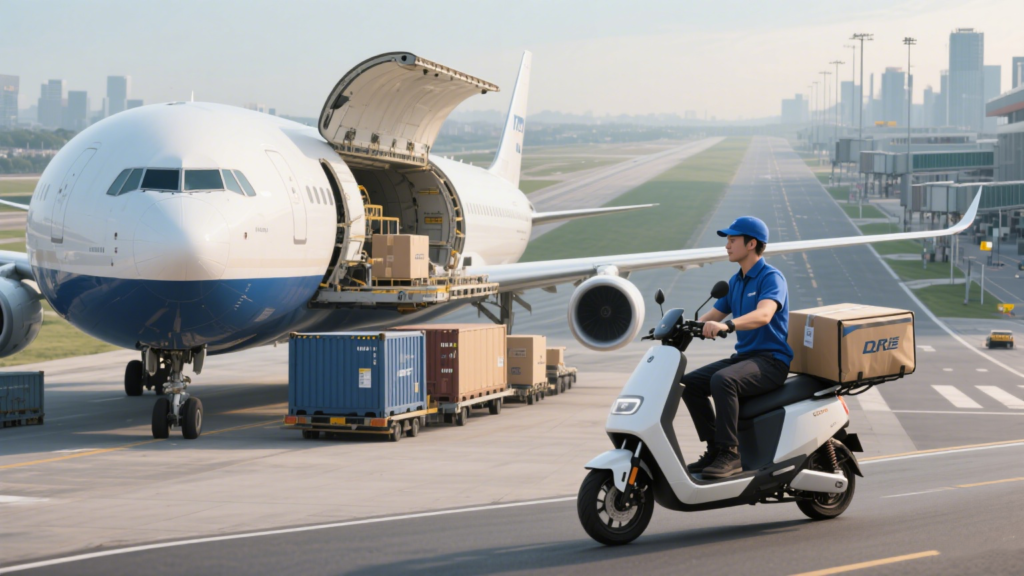
Some Tips When You Choose
Basic Requirements and Restrictions of the Major International Express Courier Companies on Shipments
| Courier Company | Max. Weight per Piece | Max. Dimensions per Piece | Volume Weight Calculation | Special Restrictions & Additional Fees |
|---|---|---|---|---|
| DHL | • 70 kg for most countries • 30 kg for some Middle Eastern countries | • Length: ≤ 120 cm • Length + Girth: ≤ 330 cm | • Formula: (L × W × H in cm) / 5000 | • Additional Fees: An extra charge applies for pieces exceeding standard limits. • Batteries: Specific restrictions apply to lithium batteries. |
| FedEx | • 68 kg (main standard) • 35 kg in the EU due to manual handling rules | • Length: ≤ 120 cm • Max. length: 274 cm • (L + 2×W + 2×H): ≤ 330 cm | • Formula: (L × W × H in cm) / 5000 | • Additional Fees: Oversize surcharge. • Remote Area Surcharge: Applies. • Residential Delivery Surcharge: Applies in North America. |
| UPS | • 70 kg (standard) • 68 kg (trigger for Heavy Goods surcharge) | • Length: ≤ 270 cm • (2 × Width + 2 × Height) + Length: ≤ 419 cm • Length: ≤ 274 cm (for oversize definition) | • Formula: (L × W × H in cm) / 5000 | • Additional Fees: An oversize surcharge is applied for non-standard pieces. • Remote Area & Residential Surcharges apply. |
Always check the latest guidelines with your chosen carrier, as policies and surcharges can change.
Key General Considerations & Tips
Volume Weight (Dimensional Weight): The chargeable weight of a shipment is determined by whichever is greater: the actual gross weight or the volume weight.
“Piece” vs. “Shipment”: There are often restrictions on both individual pieces and the entire shipment. For example, a single shipment might have a total weight limit (e.g., 300 kg for FedEx).
Additional Fees Are Common: Be prepared for various surcharges, including:
- Fuel Surcharge: Fluctuates monthly.
- Remote Area Surcharge: Applied to destinations far from urban centers.
- Residential Delivery Surcharge: For deliveries to homes rather than businesses.
- Oversize/Overweight Surcharge: Triggered when limits in the table are exceeded.
Prohibited Items: All carriers strictly forbid shipping dangerous goods (e.g., explosives, flammable liquids, certain batteries without proper certification), counterfeit items, cash, and live animals.
Customs & Documentation: Accurate commercial invoices are mandatory for international shipments. For terms like DDP (Delivered Duty Paid), the seller is responsible for all import costs. Incorrect documentation can lead to delays, seizures, or returned shipments.
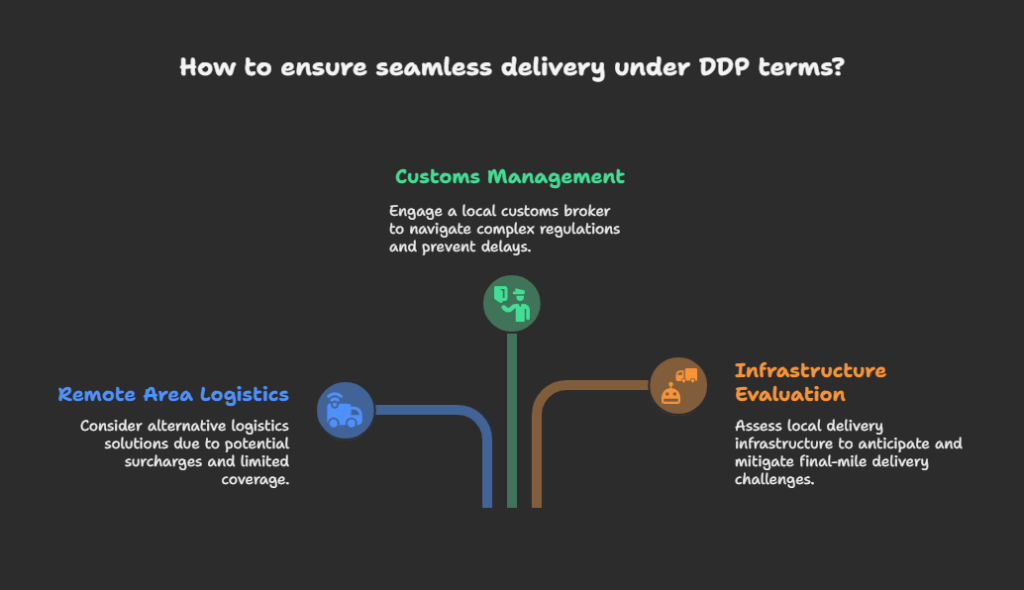
Packaging Matters: Use strong boxes, secure contents to prevent movement, and minimize empty space to avoid unnecessary volume weight charges and potential damage.
Important Note: This information above is based on publicly available data and can change. Always consult directly with the courier or your freight forwarder for the most current and specific restrictions, especially for unusual shipments or specific destinations, as rules can vary by country (e.g., lower weight limits might apply in specific regions like Nigeria or Brazil).
FAQs on Air Freight or Express Courier Services
Why was my final bill higher than the initial quote? How can I avoid hidden fees?
Always request an all-inclusive, door-to-door quote in writing. For air freight, ask for a detailed breakdown of all potential charges (handling, security, terminal fees). For couriers, confirm if surcharges are included.
My shipment is stuck in customs. How can I resolve and prevent clearance delays?
First, contact your provider to identify the exact issue (e.g., missing commercial invoice, incorrect HS code, missing certificate of origin). Submit corrected, detailed documents immediately.
To prevent this, partner with providers that have in-house customs brokerage expertise (e.g., DHL’s customs teams) to pre-verify your paperwork, ensuring smoother clearance.
I’m shipping lightweight, bulky items (e.g., foam, pillows). Why is it so expensive?
Carriers charge based on the space your shipment occupies, using Volumetric Weight.
Calculate the chargeable weight yourself first,
- Express Courier: (L x W x H in cm) / 5000
- Air Freight: (L x W x H in cm) / 6000
You will be charged based on whichever is greater: the volumetric or actual weight. If volumetric weight is high, try reducing the package size or consolidating items.
My shipment was lost or damaged. What are the immediate steps, and how can I prevent it?
- File a claim immediately with your tracking number and proof of shipment/value (e.g., commercial invoice).
- To prevent damage: Use industry-standard packaging (sturdy boxes, ample cushioning, “FRAGILE” labels).
- To prevent loss: Purchase full cargo insurance for high-value items, as carrier liability is limited.
- Monitor real-time tracking to catch anomalies early.
The carrier rejected my shipment due to restricted items. What should I do?
- Check the carrier’s official prohibited items list before booking (e.g., certain batteries, liquids, perfumes).
- For allowed restricted items (e.g., medical devices, chemicals), obtain all required certifications (e.g., FDA approval, MSDS) and declare them accurately to your provider upfront.
- Never misdeclare items.
My temperature-sensitive goods (pharmaceuticals, food) spoiled. What’s the solution?
Use specialized cold chain logistics. This includes:
- Temperature-controlled packaging (insulated containers, gel packs).
- Selecting providers with certified cold chain capabilities (e.g., Maersk Air Cargo Cold Chain, DHL Temperature Management).
- Requesting a “temperature log” for the entire journey.
- Coordinating immediate pickup upon arrival.
The last-mile delivery failed (wrong address, no attempt). How to fix and prevent this?
Contact the provider immediately to reroute (fees may apply). To prevent this:
- Double-check the address using validation tools (e.g., FedEx Address Checker).
- Provide a local contact phone number.
- Add a “signature requirement” to ensure it’s handed to the right person.
- For business addresses, specify building name and office number.
My shipment tracking hasn’t updated in days—what does this mean, and how do I get clarity?
Stalled tracking usually means the shipment is in transit between hubs, held in customs, or the tracking number wasn’t scanned.
First step: Check the provider’s tracking page for “estimated next update” (many couriers/airlines list this). If no update for 48-72 hours:
- Courier: Contact their 24/7 hotline with your tracking number—they can trace the shipment’s last scanned location.
- Air freight: Ask your forwarder for the MAWB (Master Air Waybill) number to track directly with the airline (e.g., Lufthansa Cargo, Emirates SkyCargo).
Prevention: Opt for SMS/email alerts to get real-time updates for key milestones (departure, customs clearance, arrival).
My shipment is late, and I need to meet a customer deadline—what can I do, and how to prevent this?
Delays stem from weather, customs holds, or missed flights (“roll-overs”)—mitigation depends on urgency:
- Immediate action: For couriers, ask if they offer “expedited rerouting” (fees apply) to speed up delivery. For air freight, work with your forwarder to book the next available flight.
- Prevention:
- Confirm a guaranteed delivery window in writing (e.g., “DHL Express 12:00” for next-day noon delivery) and add a 1-2 day buffer when promising customers (e.g., quote “3-4 days” if the provider guarantees 2-3).
- For air freight, avoid peak seasons (e.g., Christmas, Chinese New Year) or book flights 1-2 weeks in advance to avoid “roll-overs.”
Need more guidance? If you’re still unsure which shipping method to choose, contact our logistics experts. We provide tailored solutions based on your location, cargo needs, budget, and timeline.
Simply click the ‘Contact us’ button below, and let me know what I can do for you and your business.

